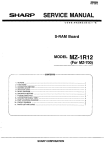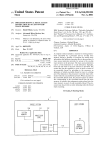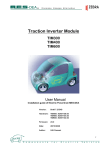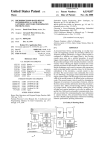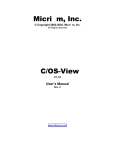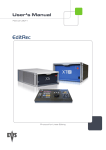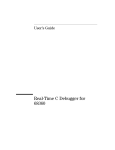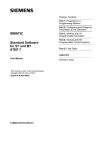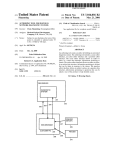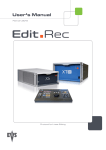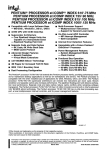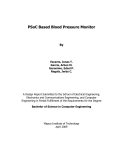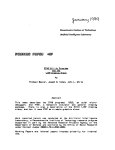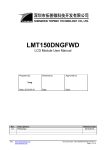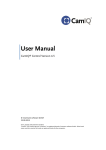Download Debug interface including operating system access of a serial
Transcript
US005978902A United States Patent [19] [11] Patent Number: Mann [45] [54] [75] DEBUG INTERFACE INCLUDING OPERATING SYSTEM ACCESS OF A SERIAL/ PARALLEL DEBUG PORT Inventor: Revill, Geoff, “Advanced On—chip Debug for ColdFire Developers”, Embedded Systme Engineering, Apr./May 1997, pp. S2—S4. Daniel P. Mann, Austin, Tex. Larus, James R., Ef?cient Program Tracing, 8153 Computer, No. 5, May 26, 1993, Los Alamitos, CA, pp. 52—61. Advanced Micro Devices, “Am29040TMMicroprocessor User’s Manual—29K Family”, Advanced Micro Devices, Inc. 1994, pp. 12—1 through 12—26. [21] Appl. No.1 08/992,276 Filed: Nov. 2, 1999 OTHER PUBLICATIONS [73] Assignee: Advanced Micro Devices, Inc., Sunnyvale, Calif. [22] Date of Patent: 5,978,902 (List continued on next page.) Dec. 17, 1997 Primary Examiner—William M. Treat Attorney, Agent, or Firm—Zagorin, O’Brien & Graham, Related US. Application Data LLP [60] Provisional application No. 60/043,070, Apr. 8, 1997. [51] Int. Cl.6 .................................................... .. G06F 11/00 [57] [52] US. Cl. ............................................. .. 712/227; 714/27 Adebug interface supports data transfer using read and Write [58] Field Of Search ............................. .. 712/227; 714/27, system calls that communicate data Without stopping an ABSTRACT executing kernel. The printf( ) command passes an infor mation string to an executing operating system. The infor 714/30, 38, 28; 395/50049 mation string summons the operating system to use a serial [56] References Cited debug port to signal to a debug device, such as a host system, that is connected to the serial port. The debug interface U.S. PATENT DOCUMENTS supported read and Write operations and system calls alloW 5,058,114 10/1991 Kuboki et al. . 5,321,828 6/1994 Phillips et a1. . 5,357,626 10/1994 Johnson et al. . the kernel and executing applications softWare, respectively, to continue executing during the read and Write data trans fers. The debug interface includes support for a plurality of extended function sideband signals that extend the function ality of the read and Write functionality to alloW the pro 5,371,689 12/1994 Tatsuma. 5,491,793 5,533,192 2/1996 Somasundaram et al. . 7/1996 Hawley et al. ......................... .. 714/28 5,642,479 6/1997 Flynn. While transferring data using read and Write operation. The 5,752,013 5,774,684 5/1998 Christensen et al. ................. .. 712/227 6/1998 Haines et a1. ......................... .. 710/129 extended function sideband signals include a command 5,774,708 5,848,264 cessor to concurrently run kernel and application programs acknowledge signal (CMDACK), a dual-purpose break 6/1998 Klingler. execution and trace control signal (BRTC), an execution 12/1998 Baird et a1. ...................... .. 395/500.49 5,867,644 2/1999 Ranson et a1. 5,889,988 3/1999 stopped and receive data signal (STOPTX), and an off-chip trigger event signal (TRIG). The debug interface further 709/224 Held ...................................... .. 709/103 includes a buffer for transferred data The kernel may run a ?rst data transfer command Which is not fully transmitted FOREIGN PATENT DOCUMENTS When a second data transfer command is issued. The oper 316609 0530816A3 636976 762276 849670 5/1989 3/1993 2/1995 3/1997 6/1998 59-194245 11/1984 European European European European European Pat. Pat. Pat. Pat. Pat. Off. Off. Off. Off. Off. ating system supports buffering of the data evoked by the second data transfer command using a conventional queuing operation. 16 Claims, 9 Drawing Sheets Japan . TRA E RECORD [20;0] DATA m STEERING . wan/M5110] CPU-DATMOUTHI: 01] 'wWUDB-CMD 4 Jl/PeCMD-DONE JMPeCMD-PENDYNG RD-UDB-CVD cwouPsEL/s: 01 cPuJNsHED 0110 l ms DARALLEL PORT PROCESSOR "WW5 m STATE m MACHINE ICK JTAG TAP CON‘ROLLER SERIAL m DEBUG sIAIE MACHINE L gamma L24 STAIE MACWE TRACE 200 BUFFER PORT AND L TRACE PAD INTERFACE-2L PDATA PADR mus. TRACE cw 5,978,902 Page 2 OTHER PUBLICATIONS K5 HDT, e—mail describing K5 HDT, Jan. 11, 1997, pp. 1—6. O’Farrell, Ray, “Choosing a Cross—Debugging Methodol ogy”, Embedded Systems Programming, Aug. 1997, pp. Motorola “CPU32 Reference Manual”, pp. 7—1 thru 7—13 84—89. Ganssle, Jack G., “Vanishing Visibility, Part 2”, Embedded Systems Programming, Aug. 1997, pp. 113—115. Oj ennes, Dan, “Debugging With Real—Time Trace”, Embed ded Systems Programming, Aug. 1997, pp. 50—52, 54, 56, (admitted prior to Apr. 8, 1997). Motorola “MEVB Quick Start Guide”, pp. 3—5 thru 7—2 (admitted prior to Apr. 8, 1997). and 58. IBM Techinical Disclosure Bulletin “Tailorable Embedded Heinicke et al., “A Real Time Integrated Environment for Motorola 680XX—based VME and FASTBUS Modules”, Event Trace”, vol. 34, No. 7B, Dec. 1991, pp. 259—261. Oct. 1989. Intel “PentiumTMProcessor User’s Manual vol. 3: Architec ture and Programming Manual”, 1994, pp. 17—1 through 17—9. IEEE Transactions on Nuclear Science, vol. 36, iss. 5, pp. 1701—1705. U.S. Patent Nov. 2, 1999 g Sheet 1 of9 ozm c SE28 wmsiom 8T L2 02% E2 § 50m% 58 N22:we \ \ / 2052@058”: E5 5,978,902 .UE H U.S. Patent Nov. 2, 1999 Sheet 3 of9 5,978,902 5.35 mo€5m m6z<E5 A cow >:m65T<oN >m:65T<oN >.m65A<153 >5m61<5 5605 560 .25 m U.S. Patent Nov. 2, 1999 Sheet 4 of9 5,978,902 0H3E;g 829531 ; 1l56E520 mom wow / 20 3%2 E;2 51m0 :wE@252: .UE w f§0M3E5;G 9Z952 ; 5a12:8 > l25?913,2 wI;5ams, :wE@2575 _ I25?323 5c7m‘2l n0 9E8V1G2MIcQ 253%2 .5%52 289E5V19%\35: U.S. Patent Nov. 2, 1999 Sheet 7 of9 START DEBUG 5,978,902 LOAD/UNLOAD NEW 38-BIT COMMAND, CHECK FINISHED FLAG 702 WRITE DEBUG INSTRUCTION TO TAP CONTROLLER 704 LOAD/UNLOAD 38-BIT SERIAL VALUE WITH PENDING BIT SET REPEAT LOAD/UNLOAD OF 38—BIT COMMAND, CHECK FINISHED FLAG FIG. 7 START DEBUG 802 WRITE DEBUG INSTRUCTION TO TAP CONTROLLER 804 806 LOAD/UNLOAD DEBUG SCAN CHAIN WITH PENDING BIT SET FIG. 8 U.S. Patent Nov. 2, 1999 Sheet 8 of9 S _ VB O O O _Emmi _Emmi @859; g_ig 3T2I5E x9520 BQUJESL EUIJE T2'5l196 6259038 5,978,902 5,978,902 1 2 DEBUG INTERFACE INCLUDING OPERATING SYSTEM ACCESS OF A SERIAL/PARALLEL DEBUG PORT information during a Branch Target Address (BTA) cycle. The BTA-cycle is stolen from regular bus operation cycles. HoWever in debug environments With high branch activity and loW cache hit rates, BTA-cycles are often fully occupied RELATED APPLICATIONS handling branches, resulting in a con?ict over access to the address bus that necessitates processor “throttle back” to prevent a loss of instruction trace information. For example, This application claims priority to US. application Ser. No. 60/043,070, ?led Apr. 8, 1997, Which is hereby incor softWare in the communications industry is branch-intensive and suffers poor cache utiliZation often resulting in 20% or porated by reference. BACKGROUND OF THE INVENTION 10 In another approach, a second “trace” or “slave” processor is combined With a main processor, With the tWo processors microprocessors. More speci?cally, the present invention operating in-step. Only the main processor fetches instruc relates to a softWare debug support system and operating method in processors. 15 increasing processor clock speeds, has placed an increasing adequate softWare debug functionality in a processor results in longer customer development times and reduces attrac tiveness of the processor for use Within industry. SoftWare debug support is particularly useful in the embedded prod ucts industry, Where specialiZed on-chip circuitry is often tions. The second, slave processor monitors fetched instruc tions on the data bus and maintains an internal state in 2. Description of the Related Art The groWth in softWare complexity, in combination With burden on application softWare developers. The cost of developing and debugging neW softWare products is noW a signi?cant factor in processor selection. A failure to include more throttle back, an unacceptable amount for embedded products Which are subject to real-time constraints. 1. Field of the Invention The present invention relates to computer systems such as 20 25 synchroniZation With the main processor. The address bus of the slave processor supplies trace information. After poWer up, via a JTAG (Joint Test Action Group) input, the second processor is sWitched into a slave mode of operation. The slave processor, freed from instruction fetch duties, uses the slave processor address bus and other pins to supply trace information. Another existing debug strategy utiliZes implementation of debug support into every processor in a system, but only bonding-out signal pins in a limited number of packages. combined With a processor core. The bond-out versions of the processor are used during The softWare debug tool con?guration of a processor addresses the needs of several parties in addition to the softWare engineer Who develops program code for execution on the processor. A “trace” algorithm developer searches through captured softWare trace data that re?ects instruction debug and replaced With the smaller package for ?nal production. The bond-out approach suffers from the need to 30 larly if a substantial number of extra pins are required by the debug support variant. Furthermore, the debug capability of execution How in a processor. An in-circuit emulator devel oper deals With problems of signal synchroniZation, clock frequency and trace bandWidth. A processor manufacturer seeks a softWare debug tool solution that avoids an increased processor cost or design and development complexity. 35 ging. HoWever, the initial task of getting the operating systems running reliably often calls for special development equipment While not standard in the desktop environment, development equipment such as logic analyZers, read-only memory (ROM) emulators, and in-circuit emulators (ICE) specially-packaged processors is unavailable in typical processor-based production systems. In yet another approach, speci?cally the Background Debug Mode (BDM) implemented by Motorola, Inc., lim ited on-chip debug circuitry is implemented for basic run In the desktop systems, complex multitasking operating systems are currently available to support softWare debug support additional bond pad sites in all fabricated devices, a burden in small packages and pad limited designs, particu 40 control. The BDM approach utiliZes a dedicated serial link having additional pins and alloWs a debugger to start and stop the target system and apply basic code breakpoints by inserting special instructions in system memory. Once 45 are sometimes used in the embedded industry. In-circuit emulators have some advantages over other debug environ halted, special commands are used to inspect memory vari ables and register contents. The BDM system includes trace support, but not conveniently using the serial link. Instead ments including complete control and visibility over the BDM system supplies trace support through additional dedicated pins and expensive external trace capture hard memory and register contents, and supplying overlay and Ware that transfer instruction trace data. trace memory if system memory is insuf?cient. Traditional in-circuit emulators are used by interfacing a ging suffer from a variety of limitations including increased custom emulator back-end With a processor socket to alloW packaging and development costs, circuit complexity, pro communication betWeen emulation equipment and the target system. The custom design of emulator interfaces in increas ingly unrealistic and expensive as product life cycles are reduced and nonstandard and exotic integrated circuit pack ages are predominant in present day processor design. FeW knoWn processor manufacturing techniques are cessor throttling, and bandWidth matching difficulties. Accordingly, present day techniques for softWare debug Furthermore, no adequate loW-cost procedure for providing 55 available that include a suitable full-function in-circuit emu lation functionality. Most processors in personal computer In a conventional system, a processor discontinues execu 60 (PC) systems implement emulation functionality using a multiplexed approach in Which existing pins are multiplexed Some advanced processors multiplex debug pins in time, for example by using the address bus to report softWare trace tion in the debug mode and sets a stop transmit signal. An external system detects assertion of a stop and interrogates a debug port to determine the reason for termination of for alternative use in a softWare debug application. Multi plexing of pins is not desirable in embedded controllers, Which inherently suffer from overload of pin functionality. trace information is currently available. The limitations of the existing solutions are likely to be exacerbated in the future as internal processor clock frequencies continue to increase. 65 execution. Reasons for termination include, for example, a breakpoint, an illegal memory access, and transport of a printf( ) data string. The conventional system accesses a printf( ) data string, transfers the data string via the JTAG port, sends the printf( ) data string to a source-debug 5,978,902 3 4 console, and sends a signal to the source-console designat ing that the command is terminated, the processor has stopped executing and the reason that execution is stopped. The processor is then enabled to begin execution and the interrupted program continues execution. Termination of execution may be suitable for debugging in kernel mode, but running of a softWare system and a debug interface con nected to the processor core and connectable to an external softWare debug device. The softWare system includes input/ output function calls. The external softWare debug device detects operating signals generated by the processor core during running of the softWare system. The softWare system transfers debug information via the debug interface using the is generally unacceptable in application mode for many applications. input/output function calls While the processor core contin ues execution during a data transfer of the input/output function calls. The printf( ) data transfer is cumbersome because the printf( ) command heavily intrudes into the operation of the processor. In the conventional system, entry into debug mode demands that the processor stops executing, and the debug port generates a signal indicating that the processor BRIEF DESCRIPTION OF THE DRAWINGS The present invention may be better understood, and its has stopped and the reason the processor has stopped is to deliver a printf( ) string. Accordingly, in the conventional 15 system each time a printf( ) command is executed in the kernel mode debug or an application mode by a target system processor, the processor has to stop all ruing appli cations and stop execution of the kernel. AWell-knoWn and highly critical problem With in-circuit draWings. FIG. 1 is a schematic block diagram shoWing a softWare debug environment utiliZing a softWare debug port accord ing to an embodiment of the present invention. FIG. 2 is a schematic block diagram illustrating details of an exemplary embedded processor product incorporating a emulation (ICE) systems is that a debug operation using ICE demands that the process executing in the target processor undergoing the debug operation must stop execution to alloW examination of operating conditions and signals. Therefore, the advantage of the ICE system in alloWing full softWare debug port according to the present invention. FIG. 3 is a simpli?ed block diagram depicting the rela 25 control and visibility of data such as program trace data is countered by the disadvantage of stopping execution of the processor. When the processor stops, all interrupt handling stops, a highly disadvantageous condition in real-time envi FIG. 4 is a ?oWchart illustrating softWare debug com mand passing according to one embodiment of the inven ronments such as communication and netWork environ tion; FIG. 5 is a ?oWchart illustrating enhanced softWare port command passing according to a second embodiment of the What is needed is an apparatus and operating technique that alloWs a debug system full visibility and access to data, including a program trace capability, While permitting the invention; and 35 tinue running While the debug data is accessed. SUMMARY OF THE INVENTION debug interface supports data transfer using read and Write system calls that communicate data Without stopping an executing kernel. The printf( ) command passes an infor mation string to an executing operating system. The infor mation string summons the operating system to use a serial 45 supported read and Write operations and system calls alloW FIG. 9 is a timing diagram shoWing signal behavior for acquisition and release of a parallel debug bus. FIG. 10 is a How chart depicting a parallel debug port interface protocol folloWed by the host system during com munications via the parallel port. The use of the same reference symbols in different draW ings indicates similar or identical items. the kernel and executing applications softWare, respectively, to continue executing during the read and Write data trans fers. The debug interface includes support for a plurality of extended function sideband signals that extend the function ality of the read and Write functionality to alloW the pro DESCRIPTION OF THE PREFERRED EMBODIMENT(S) cessor to concurrently run kernel and application programs While transferring data using read and Write operation. The extended function sideband signals include a command FIGS. 6A—6G illustrate the general format of a variety of trace buffer entries for reporting instruction execution according to the invention. FIG. 7 is a state diagram illustrating states of a standard JTAG interface access operation. FIG. 8 is a state diagram illustrating states of an enhanced JTAG interface access operation. In accordance With an aspect of the present invention, a debug port to signal to a debug device, such as a host system, that is connected to the serial port. The debug interface tionship betWeen an exemplary instruction trace buffer and other components of an embedded processor product according to the present invention; ments. processor, kernel softWare and application softWare to con numerous objects, features, and advantages made apparent to those skilled in the art by referencing the accompanying 55 acknoWledge signal (CMDACK), a dual-purpose break execution and trace control signal (BRTC), an execution stopped and receive data signal (STOPTX), and an off-chip trigger event signal (TRIG). The debug interface further Referring to FIG. 1, a schematic block diagram illustrates a softWare debug environment utiliZing a debug port 100. A target system 101 is shoWn containing an embedded pro cessor device 102 coupled to system memory 106. The embedded processor device 102 is an integrated debug interface for ?exible, high-performance in an embedded hardWare/softWare debug system. The embedded processor includes a buffer for transferred data. The kernel may run a device 102 includes a processor core 104 and the debug port 100. In some embodiments, the embedded processor device ?rst data transfer command Which is not fully transmitted When a second data transfer command is issued. The oper 102 may incorporate additional circuitry (not shoWn) for ating system supports buffering of the data evoked by the performing application speci?c functions, or may take the second data transfer command using a conventional queuing operation. In accordance With an embodiment of the present invention, a processor includes a processor core supporting form of a stand-alone processor or digital signal processor. 65 In the illustrative embodiment, the debug port 100 includes an IEEE-1149.1-1990 compliant JTAG interface or other similar standardiZed serial port interface. 5,978,902 6 5 devices in response to internal breakpoints, and by elimi nating status polling of the JTAG serial interface. The sideband signals offer extra functionality and improve com munications speeds for the debug port 100, but are optional and not utiliZed in the simplest embodiments of debug port 100 Which uses conventional JTAG support signals. In the illustrative embodiment the sideband signals are used With an optional parallel port 214 provided on special bond-out A host system 111 is used to execute debug control software 112 for transferring high-level commands and controlling the extraction and analysis of debug information generated by the target system 101. The host system 111 and target system 101 of the disclosed embodiment of the invention communicate via a serial link 110. Most comput ers are equipped With a serial or parallel interface Which can be inexpensively connected to the debug port 100 by means of a serial connector 108, alloWing most computers to function as a host system 111. In some embodiments, the serial connector 108 is replaced With higher speed JTAG to-netWork conversion equipment. Referring to FIG. 2, a schematic block diagram illustrates the embedded processor device 102 in more detail, including the processor core 104 and various elements of the debug port 100 in an enhanced form. The embedded processor device 102 includes a plurality of state machines that 10 15 data output signal TDO are received by the serial debug shifter 212 via the JTAG TAP controller 204 so that com communicate messages and data betWeen a serial port of a J TAG TAP controller 204, a trace control circuit 218, and the mands and data are loaded into debug registers 210 and read from the debug registers 210. In the disclosed embodiment, the debug registers 210 include tWo debug registers for processor core 104. In some embodiments, the embedded processor device 102 includes a parallel port 214 and the state machines similarly establish communication betWeen transmitting (TXiDATA register) and receiving (RXi DATA register) data, an instruction trace con?guration reg the parallel port 214, the trace control circuit 218, and the ister (ITCR), and a debug control status register (DCSR). processor core 104. The state machines include a debug port state machine 206, a parallel port state machine 226, a processor interface state machine 202, and a pending/?nished state machine 224. The state machines read the commands and data from Data are typically read from the JTAG TAP controller 204 25 The Instruction Trace Con?guration Register (ITCR) is Written to control enabling, disabling, and con?guration of Instruction Trace debug functions. The ITCR is accessed through the serial/parallel debug register Write/read com mands or by using a reserved instruction LDTRC. from memory, utiliZe processor core 104 intervention and are appropriately sent to the processor core 104. The state The Debug Control/Status Register (DCSR) indicates 35 When the processor core 104 enters debug mode and alloWs the processor core 104 to be forced into debug mode using the enhanced JTAG interface. DCSR also includes miscel laneous control feature enables bits. DCSR is accessible only through the serial/parallel debug register Write/read commands. A minimal embodiment of the debug port 100 supports only conventional JTAG pins in a fast JTAG compliant interface that advantageously attains controllability and observability. The JTAG pins are a transportation mecha nism that use existing pins to enter commands for perfor mance by the processor core 104. Conventional JTAG pins carry conventional JTAG support signals that are Well knoWn in the art including a test clock signal TCK, a test using a Capture DR-Update DR sequence in the JTAG TAP controller state machine. the serial/parallel ports and direct decoding of the com mands by a command decode and processing block 208 logic. Some commands, such as a command for reading data machines do not accept further commands until execution of a previous command is complete. Once the command is completed, a ?ag in a Debug Registers 210 block is asserted or an output pin is asserted to indicate command completion to the host system 111. versions of the embedded processor device 102. Using conventional JTAG signals, the JTAG TAP con troller 204 accepts standard JTAG serial data and control signals. When public JTAG DEBUG instruction is Written to a JTAG instruction register, the serial debug shifter 212 is connected to a serial interface formed by the JTAG TAP controller 204. AJTAG test data input signal TDI and a test A debug port state machine 206 coordinates loading and reading of data betWeen the serial debug shifter 212 and the debug registers 210. The debug port state machine 206 45 mode select signal TMS, a test data input signal TDI, and a test data output signal TDO. The conventional JTAG pins interfaces to the J TAG TAP controller 204 via a parallel port state machine 226. Acommand decode and processing block 208, and the processor interface state machine 202, in combination, decode commands and data and dispatch the commands and data to a data steering circuit 222 Which, in turn, communicates With the processor core 104 and trace control circuit 218. The processor interface state machine 202 communicates directly With the processor core 104 and a trace control circuit 218. Aparallel port 214 communicates are driven by a JTAG Test Access Port (TAP) controller 204. The JTAG interface is enhanced to improve softWare debug capabilities and to transfer high-level commands into With the debug port state machine 206 and the data steering circuit 222 to perform parallel data read and Write operations in optional bond-out versions of the embedded processor the processor core 104, rather than to scan processor pins. The JTAG-compliant serial interface is augmented for higher-speed access via supplemental sideband signals and bondout package to fully support the enhanced 10-pin debug device 102. The trace control circuit 218 generates trace record infor mation for reconstructing instruction execution How in the processor core 104. The trace control circuitry 218 interfaces port 100 format. The enhanced embodiment of the debug port 100 supports the four additional pins carrying “side trace pad interface port 220, Which is also called a DEBUG band” signals including a command acknowledge signal trace port 220, or to an internal trace buffer 200 and CMDACK, a break request/trace capture signal BRTC, a stop transmit signal STOPTX, and a trigger signal TRIG to the standard JTAG interface. The additional sideband signals implements user control for selectively activating and deac tivating trace functionality. The trace control circuitry 218 a bond-out parallel interface With a 16-bit data path. Speci?cally, four pins are added to an embedded processor device 102 that supports JTAG functionality in a non advantageously enhance performance and functionality of the debug port 100 by attaining highly precise external breakpoint assertion and monitoring, by triggering external 55 to the processor core 104 and supports tracing either to a 65 controls a trace pad interface port 220 Which, in the illus trative embodiment, shares communication lines of the parallel port 214. When utiliZed, the trace pad interface port 220 supplies trace data While the processor 104 is executing 5,978,902 7 8 instructions, although clock synchronization and other dif to the parallel port 214 until the trace buffer 220 is empty. ?culties may arise. The trace control circuitry 218 enables The trace buffer 220 is functionally used as a circular buffer other features including programmability of synchronization for the internal trace mode of operation. Trace records overWrite existing data after 256 records are Written into the trace buffer 200. address generation and user speci?ed trace records. The processor core 104 supplies the tracing information that is used to generate trace records. The debug port interface 100 supplies the commands to enable and disable The JTAG TAP controller 204 functions as an IEEE 1149.1-1990-compliant serial command port that serves as a the trace function, and to turn trace capture on and off via the ITCR. Commands to read the trace buffer come from the processor core 104. At reset, tracing is disabled and trace 10 debug port 100 using only conventional JTAG signals, the port 100 is enabled by Writing the public JTAG instruction capture is turned off. To begin generating trace records, tracing is enabled and trace capture turned on. When the processor core 104 enters the debug mode, trace capture is turned off. When the processor core 104 exits debug mode, trace capture status returns to the state prior to entering primary mode of communication betWeen a host processor 111 and target processor to a maximum TCK rate of 25 MHZ. Before debug information is communicated via the 15 debug mode. DEBUG into a JTAG instruction register contained Within the J TAG TAP controller 204. The J TAG instruction register is a 38-bit register including a 32-bit data ?eld debugidata [31:0], a four-bit command ?eld cmd[3:0] to point to various internal registers and functions provided by the debug port Tracing is enabled by setting the GTEN bit in the ITCR. Tracing is disabled by resetting the GTEN bit. When tracing is disabled, all trace records are discarded from the trace 100, a command pending ?ag (P), and a command ?nished ?ag Some commands use bits of the debugidata ?eld buffer 200. Trace capture is turned on by setting the TRON bit in the ITCR. Trace capture is turned off by resetting the The pending and ?nished ?ags are controlled by a pending/ TRON bit. The TRON bit is modi?ed in one of several Ways ?nished state machine 224 that is connected to the JTAG TAP controller 204. as a sub-?eld to extend the number of available commands. including directly Writing to the TRON register, applying the break request/trace capture signal BRTC if the BTRC is enabled in the DCSR to control trace capture, and via 25 J TAG Instruction Register DRO—DR3 register usage to turn trace capture on/off by enabling the option in the ITCR. The disabling of trace gathering is advantageously a softWare option, reducing processor poWer consumption and eliminating natural throttle-back tendencies. Trace gathering 37 is enabled both from the host system 111 and the target system 101. Trace information is not generated When the test mode select signal TMS. The test mode select signal TMS alloWs the JTAG clocking path to be changed in the 2 This JTAG instruction register is selected by toggling the processor is operating in Debug mode. All other modes may be “traced” if the appropriate sWitches are set. When tracing is disabled, contents of the trace buffer 200 are lost. HoWever, When commands or trace/breakpoint 54 debugfdata[31:0] scan path, enabling usage of multiple paths of varying 35 control registers are used to temporarily stop/start trace accumulation, the trace buffer 200 is not ?ushed. lengths. Preferably, the JTAG instruction register is acces sible via a short path. This register is con?gured to include a soft register for holding values to be loading or receiving from speci?ed system registers. Referring noW to FIG. 3, a simpli?ed block diagram depicts the relationship betWeen an exemplary instruction The trace control circuit 218 operates in one of tWo modes, external trace mode and internal trace mode, that trace buffer 200 and other components of an embedded differ in hoW the controller handles the trace records asso processor device 102. In one embodiment, the trace buffer ciated With trace events. The external trace mode is available 200 is a 25 6 entry ?rst-in, ?rst-out (FIFO) circular cache that on a bondout chip. In external trace mode, trace records are records the most recent trace entries. Increasing the siZe of sent to the trace port 220. External trace mode is enabled by 45 the trace buffer 200 increases the amount of instruction trace setting ITM=1 in the ITCR. The internal trace buffer tem information that is captured, although the amount of porarily stores trace records that cannot be sent to the trace required silicon area may increase. port at the same rate as the records are generated by the The trace buffer 200 stores a plurality of 20-bit (or more) processor core 104. trace entries indicative of the order in Which instructions are The internal trace mode is available on both a bondout and executed by the processor core 104. Other information, such a non-bondout integrated circuit. In the internal trace mode, as task identi?ers and trace capture stop/start information, is also placed in the trace buffer 200. The contents of the trace buffer 200 are supplied to external hardWare, such as the trace records are stored in the internal trace buffer 200. The internal trace mode is enabled by setting ITM=0 in the ITCR. The trace buffer 200 contents are accessed either The trace buffer 200 improves bandWidth matching and reduces the need to incorporate throttle-back circuitry in the host system 111, via either serial or parallel trace pins 230. Alternatively, the target system 101 can be con?gured to examine the contents of the trace buffer 200 internally. Referring to FIG. 4, a high-level ?oW chart illustrates a technique for passing a command When using a standard processor core 104. In one embodiment, the trace buffer 200 JTAG interface. Upon entering debug mode in step 400 the is a 256 entry ?rst-in, ?rst-out (FIFO) circular cache. Increasing the siZe of the trace buffer 200 increases the amount of softWare trace information that is captured. DEBUG instruction is Written to the TAP controller 204 in step 402. In step 404, the 38-bit serial value is shifted in as through debug port commands or through the enhanced x86 instruction STBUF. 55 a Whole, With the command pending ?ag set and desired data When the processor core 104 takes a debug trap, the trace (if applicable, otherWise Zero) in the data ?eld. Control buffer might contain trace records. The processor core 104 proceeds to step 406 Where the pending command is loaded/ Will continue to send trace records to the trace port 220 until 65 unloaded and the command ?nished ?ag checked. Comple the buffer is empty. If the TBUS signals are shared With the tion of a command typically involves transferring a value betWeen a data register and a processor register or memory/ parallel debug port 214, the trace port 220 does not switch 5,978,902 10 IO location. After the command has been completed, the processor 104 clears the command pending ?ag and sets the command ?nished ?ag, at the same time storing a value in the data ?eld if applicable. The entire 38-bit register is scanned to monitor the command ?nished and command pending ?ags. If the pending ?ag is reset to Zero and the ?nished ?ag is set to one, the previous command has command ?nished ?ag status is accessible When using the ?nished. The status of the ?ags is captured by the debug port not started by the host system 111 until the command state machine 206. A slave copy of the ?ag status is saved internally to determine if the next instruction should be loaded. The slave copy is maintained due to the possibility of a change in ?ag status betWeen TAP controller 204 states, alloWing the processor 104 to determine if the previous instruction has ?nished before loading the next instruction. If the ?nished ?ag is not set as determined in step 408, control proceeds to step 410 and the loading/unloading of the 38-bit command is repeated. The command ?nished ?ag is also checked. Control then returns to step 408. If the ?nished ?ag is set as determined in step 408, control returns to step 406 for processing of the next command. DEBUG mode is exited via a typical JTAG process. Returning to FIG. 2, the optional sideband signals are utiliZed in the enhanced debug port 100 to provide extra command acknoWledge signal CMDACK Without shifting out the JTAG instruction register. The command acknoWl edge signal CMDACK transitions high on the next rising edge of the test clock signal TCK after the command ?nished ?ag has changed from Zero to one. When using the enhanced JTAG signals, a neW shift sequence in step 506 is 10 With the test clock signal TCK. The test clock signal TCK is not necessarily clocked at all times, but is ideally clocked continuously When Waiting for a command acknoWledge signal CMDACK response. 15 OPERATING SYSTEM/APPLICATION COMMUNICATION VIA THE DEBUG PORT Also included in debug register block 210 is an instruction trace con?guration register (ITCR), a 32-bit register for enabling/disabling and con?guring instruction trace debug functions. Numerous functions are contemplated including various levels of tracing, trace synchroniZation force counts, trace initialiZation, instruction tracing modes, clock divider functionality. The optional sideband signals include a break request/trace capture signal BRTC that functions as a break request signal or a trace capture enable signal depending on the status of bit set in the debug control/status register. If set to function as a break request signal, the break request/trace capture signal BRTC is asserted to cause the processor 104 acknoWledge signal CMDACK pin is asserted high. The command acknoWledge signal CMDACK is synchronous 25 ratio information, as Well as additional functions shoWn in the folloWing table. The ITCR is accessed through a JTAG instruction register Write/read command as is the case With the other registers of the debug register block 210, or via a reserved instruction. to enter debug mode. The processor 100 is also stopped by Instruction Trace Con?guration Register ITCR scanning in a halt command via the convention JTAG signals. If set to function as a trace capture enable signal, BIT asserting the break request/trace capture signal BRTC enables trace capture. Deasserting the signal turns trace capture off. The signal takes effect on the next instruction boundary after the signal is detected and is synchroniZed SYMBOL 31 :30 Reserved 35 29 RXINTEN 28 TXINTEN DESCRIPTION/FUNCTION Reserved Enables interrupt When RX bit is set Enables interrupt When TX bit is set 27 TX The trigger signal TRIG is con?gured to pulse Whenever 26 RX an internal processor breakpoint has been asserted. The trigger signal TRIG may be used to trigger an external 25 24 DISL1TR DISLOTR Disables level 1 tracing Disables level 0 tracing 23 DISCSB Disables current segment base trace record With the internal processor clock. The break request/trace capture signal BRTC is selectively asserted at any time. capturing device such as a logic analyZer, and is synchro niZed With the trace record capture clock signal TRACE CLK. When a breakpoint is generated, the event is synchro niZed With the trace capture clock signal TRACECLK, after Which the trigger signal TRIG is held active for the duration and placed in the RXiDATA register 22:16 TSYNC[6:O] Sets the maximum number of Branch Sequence trace records that may be output by the trace control block before a synchronizing address record is forced 45 of trace capture. The stop transmit signal STOPTX is asserted When the processor 104 has entered DEBUG mode and is ready for register interrogation/modi?cation, memory or I/O reads and Writes through the debug port 100. In the disclosed embodi ment of the invention, the stop transmit signal STOPTX re?ects the state of a bit in the debug control status register (DCSR). The stop transmit signal STOPTX is synchronous 55 With the trace capture clock signal TRACECLK. 15 14 13 12 TSR3 TSR2 TSR1 TSRO Sets Sets Sets Sets described in conjunction With FIG. 5, Which shoWs a sim 11 1O 9 8 TRACE3 TRACE2 TRACE1 TRACEO Enables Enables Enables Enables 7 6:4 TRON TCLK[2:O] 3 ITM Trace on/off Encoded divider ratio between internal processor clock and TRACECLK Sets internal or external (bond-out) instruction trac 2 TINIT Trace initialization 1 TRIGEN Enables pulsing of external trigger signal TRIG clears clears clears clears Trace Trace Trace Trace trace trace trace trace mode mode mode mode mode mode mode mode on on on on toggling toggling toggling toggling DR3 DR2 DR1 DRO trap trap trap trap using using using using DR3 DR2 DR1 DRO following receipt of any legacy debug breakpoint; pli?ed command passing operation in the enhanced debug independent of the Debug Trap Enable function in port 100 of FIG. 2. A DEBUG instruction is Written to the the DCSR O TAP controller 204 in step 502 to place the target system 111 into DEBUG mode. Control proceeds to step 504 and the GTEN Global enable for instruction tracing through the internal trace buffer or via the external (bond-out) interface command acknoWledge signal CMDACK is monitored by system 111 simultaneously With the command ?nished ?ag and remains high until the next shift cycle begins. The or or or or ing mode The command acknoWledge signal CMDACK is the host system 111 to determine command completion status. The CMDACK signal is asserted high by the target Indicates that the target system 111 is ready to transmit data to the host system 111 and the data is available in the T'XiDATA register Indicates that data has been received from the host 65 Another debug register is the debug control/status register (DCSR) that designates When the processor 104 has entered debug mode and alloWs the processor 104 to be forced into 5,978,902 11 12 These read-Write services are supported by operating DEBUG mode through the enhanced JTAG interface. As shown in the following table, the DCSR also enables mis system or device driver softWare that can control the opera cellaneous control features including forcing a ready signal tions and communication of data by other debug ports. These services typically include read and Write services and to the processor 104, controlling memory access space for accesses initiated through the debug port, disabling cache 5 control selection services. Library layer operations such as ?ush on entry to the DEBUG mode, supplying transmit and printf( ) and scanf( ) system calls include formatting soft received bits TX and RX, enabling the parallel port 214, forced breaks, forcing a global reset, and other functions. Ware and utiliZe loW-level services. The printf() and scanf() system calls, When operating at the application privilege The ordering or inclusion of the various bits in either the ITCR or DCSR is a design choice that typically depends on level make privilege system calls to access loW-level ser vices. the application and processor implementing the debug sys In a multitasking operating system, the illustrative embed ded processor device 102 supports a debug functionality during the operating of a plurality of tasks permitting tem. Debug ControlZStatus Register DCSR 15 BIT SYMBOL 31:12 Reserved 11 TX DESCRIPTION/FUNCTION environments. Similarly, the embedded processor device Reserved While executing various types of programs that control 102 supports testing and analysis of the target system 101 Indicates that the target system 111 is ready to transmit data to the host system 111 and the data is available in the TXiDATA register Indicates that data has been received from the host 20 and placed in the RXiDATA register 9 8 DISFLUSH SMMSP Disables cache ?ush on entry to DEBUG mode STOP cesses initiated through the Debug Port 100 Indicates Whether the processor 104 is in DEBUG mode (equivalent to stop transmit 5 FRCRDY BRKMODE 25 DBTEN parallel port 214. Debug softWare may be generated that Enables entry to debug mode or toggle trace mode 35 mechanisms 2 PARENB DSPC 1 FBRK O FRESET generates printf( ) statements in operating tasks including debug printf( ) statements, but also include nondebug printf( ) statements including operating system and applica tion printf( ) statements. The combined debug, operating system, and application information may be formatted on a Enables parallel port 214 display screen in various con?gurations to produce highly Disables stopping of internal processor clocks in the Halt and Stop Grant states informative displays. The embedded processor device 102 supports communication of character strings throughout the Forces processor 104 into DEBUG mode at the next instruction boundary (equivalent to pulsing the external BRTC pin) function calls, respectively, that advantageously extend the debug functionality of the target system 101. For example, be used to control debug hardWare and softWare including the debug port such as the serial debug port (SDP) and the enable on a trap/fault via processor 104 registers DRO-DR7 or other legacy debug trap/fault input and output interactions via the scanf( ) and printf( ) an I/O control function call and other loW level services may Forces the ready signal RDY to the processor 104 to be pulsed for one processor clock; useful When it is apparent that the processor 104 is stalled Waiting for a ready signal from a non-responding device Selects the function of the break request/trace cap ture signal BRTC (break request or trace capture on/off) 4 the problems of conventional debug systems in integrating operating system softWare, in-circuit emulation hardWare, The illustrative embedded processor device 102 supports signal STOPTX 6 multiple hardWare subsystems. Operating system support of debug functionality avoids and target system hardWare. Controls memory access space (normal memory space/system management mode memory) for ac 7 in-depth testing and analysis of the operations of the target system 101 in multiple various operating conditions and 40 target system 101, for example through printf( ) support of the JTAG TAP controller 204, the parallel port 214, and the Forces global reset trace port 220. The embedded processor device 102 further supports communication of the data from the target system 101 to the host system 111 using kernel mode and applica When operating in a cross debug environment such as the environment shoWn in FIG. 1, a parent task running on the 45 tion debug softWare support to display information on a target system 111 sends information to the host platform 101 that controls the target system 101. The information may include, for example, a character stream from a printf() call or register information from a Task Control Block (TCB). In one technique for transferring the information, an operating system places the information in a knoWn region then causes source debugger console WindoW. Debug information is transferred using the kernel printf( ) command With the processor core 104 continuing execution during the printf() data transfer. In one embodiment of a target system 101 that includes debug functionality, softWare supports an application mode printf( ) command and a kernel mode printf( ) command. DEBUG mode to be entered via a trap instruction. The printf( ) call is a Well-knoWn function or procedure call in programming languages such as tie C++ language and The embedded processor device 102 is speci?ed to operate so that the processor core 104 continues to execute during is typically supported in operating systems including various execution of a printf( ) command and during transfer of a WindoWsTM operating systems such as WindoWs CETM. In in the processor core 104 of the target system 101 supports printf( ) data string. The debug port 100 responds to acti vating signals from the host system 111 by generating a printf( ) call that generates signals to the processor interface state machine 202 to support operating system printf( ) command and quickly enter the kernel operating the illustrative embodiment, an operating system performing access to information stored in the trace buffer 200. The read-Write services and function calls advantageously make debug information available to the operating system Which may be exploited by the operating system to enable the operating system to perform debug functions. Accordingly, the operating system attains a debug function ality Without adding the signi?cant hardWare of conven tional debug tools. signals that cause the processor core 104 to perform a 60 mode and assemble a character string that causes the pro cessor core 104 to enter the debug mode. The embedded processor device 102 supports data trans fer using printf() and scanf( ) commands that communicate data Without stopping an executing kernel. The printf( ) command passes an information string to an executing operating system. The information string summons the oper ating system to use a serial debug port 100 to signal to a 5,978,902 14 13 The information transfer technique using the RXiDATA debug device, such as the host system 111, that is connected to the serial port 100. The embedded processor device supported printf( ) command allows the kernel and execut ing applications softWare to continue executing during the printf( ) data transfer. The embedded processor device 102 and TXiDATA registers enables an operating system or application to communicate With the host system 111 With out stopping processor 104 execution. Communication is conveniently achieved via the debug port 100 With minimal includes support for a plurality of extended function side impact to on-chip application resources. In some cases it is band signals that extend the functionality of the printf( ) necessary to disable system interrupts. This requires that the command to alloW the processor to concurrently run kernel RX and TX bits be examined by the processor 100. In this situation, the communication link is driven in a polled mode. and application programs While transferring data using a printf( ) command. The extended function sideband signals 10 include a command acknowledge signal (CMDACK), a dual-purpose break execution and trace control signal (BRTC), an execution stopped and receive data signal (STOPTX), and an off-chip trigger event signal (TRIG). PARALLEL INTERFACE TO DEBUG PORT 100 The serial debug port (SDP) is accessed either With the 15 JTAG-based serial link (JTAG based) or a someWhat more The kernel may run a ?rst printf( ) command Which is not parallel interface. The parallel port 214 interface supports fully transmitted When a second printf( ) command is issued. The operating system supports buffering of the data evoked by the second printf( ) command using a conventional higher code doWn-load speeds, but is included in a bond-out part. Full-function ICE developers are typical users of the bond-out parts. queuing operation. A full-function In Circuit Emulator (ICE) uses a dual The host system 111 uses debug port 100 commands to determine the reason for entering DEBUG mode and ported pod-space memory to gain high speed access to the target system 101 to gain faster doWn-load speeds than are responds by retrieving the information from the reserved region. HoWever, normal processor execution is stopped relatively complex dual-port design that is different for While the processor 104 is in DEBUG mode, an undesirable available With the serial debug port alone. To avoid a 25 The undesirable condition is addressed in the illustrative various target processors, an alternative the T/P input pin is implemented in bond-out versions only and used to sWitch the bond-out pins from a trace mode to parallel port mode. system by supplying tWo debug registers in the debug port 100 including registers for transmitting data (TXiDATA register) and receiving (RXiDATA register) data. The Some embedded systems specify that instruction trace is to be examined While maintaining I/O and data processing operations. Without the use of a multi-tasking operating condition for real-time systems. TXiDATA and RXiDATA registers are accessed using the soft address and JTAG instruction register commands. The soft address is auto-incremented to assist data transfer. After the host system 111 Writes a debug instruction to the JTAG system, a bond-out version of the embedded processor 35 instruction register, the serial debug shifter 212 is connected to the test data input signal TDI line and test data output signal TDO line. In the disclosed embodiment, a parallel port 214 is implemented in an optional bond-out version of the embed ded processor device 102 to support parallel command and data access to the debug port 100. The parallel port 214 interface forms a 16-bit data path that is multiplexed With the The processor 104 executes code that transmits data by ?rst testing a TX bit in the ITCR. If the TX bit is set to Zero then the processor 104 executes either a memory or I/ O Write instruction to transfer the data to the TXiDATA register. The debug port 100 sets the TX bit in the DCSR and ITCR, indicating to the host system 111 a readiness to transmit data, and asserts the STOPTX pin high. After the host system 111 trace pad interface port 220. More speci?cally, the parallel port 214 supplies a 16-bit Wide bi-directional data bus 45 TRACECLOCK (TC). Although not shared With the trace register, the TX bit is set to Zero. A TXINTEN bit in the ITCR is then set to generate a signal to interrupt the pad interface port 220, a parallel bus request/grant signal pair PBREQ/PBGNT (not shoWn) are also implemented. processor 104. The interrupt is generated only When the TX The parallel port 214 is enabled by setting a bit in the DCSR. bit in the ITCR transitions to Zero. When the TXINTEN bit Serial communications via the debug port 100 are not is not set, the processor 104 polls the ITCR to determine the status of the TX bit to further transmit data. disabled When the parallel port 214 is enabled. The host system 111 transmits data by ?rst testing a RX 55 The bond-out TC pin is a trace capture clock, a clock signal that is also used to capture system memory accesses performed on other busses. Capturing system bus activity is used to trace bus activity in conjunction With program trace. The TC clock is preferentially accessed last in a sequence of clock signals since system bus data can be acquired at the time of the TC clock signal. Thus other bus signals are to remain active at the time of the TC clock, or be latched in the ICE preprocessor and held until the TC clock is active. processor 104. This interrupt is only generated When the RX in the ITCR transitions to one. When the RXINTEN bit is not set, the processor 104 polls the ITCR to verify the status of the RX bit. If the RX bit is set to one, the processor instruction is executed to read data from the RXiDATA When the parallel port 214 is selected, rather than the register. After the data is read by the processor 104 from the RXiDATA register the RX bit is set to Zero. The host (PDATA[15 10]), a 3-bit address bus (PADR[2:0]), a parallel debug port read/Write select signal (PRW), a trace valid signal TV and an instruction trace record output clock completes reading the transmit data from the TXiDATA bit in the ITCR. If the RX bit is set to Zero, the host system 111 Writes the data to the RXiDATA register and the RX bit is set to one in both the DCSR and ITCR. A RXINT bit is then set in the ITCR to generate a signal to interrupt the device 102 is preferable to supply trace data since, otherWise, examination of the trace buffer 200 via the debug port 100 requires the processor 104 to be stopped. 65 trace port 220, the TC clock is used to read and Write parameters in to the Debug Registers 210, a faster process system 111 continuously reads the ITCR to determine the than serially clocking data into the 38-bit JTAG instruction status of the RX bit to further send data. command register. 5,978,902 15 16 offers full visibility of execution history without throttling the processor core 104. The trace buffer 200, if needed, is con?gured for use as a buffer to the parallel port 214 to Bond-Out Pins/Parallel Port 214 Format 21 TV 2O TC 19 PRW alleviate bandwidth matching issues. 16 PADR [2:0] OPERATING SYSTEM AND DEBUGGER INTEGRATION PDATA [15:0] The parallel port 214 is primarily intended for fast downloads/uploads to and from target system 111 memory. However, the parallel port 214 may be used for all debug communications with the target system 111 whenever the processor 104 is stopped. The serial debug signals, either In the illustrative embodiment, the operation of all debug 10 from a monitor program, a target hosted debugger, or conventional pod-wear. The debug port 100 performs data standard or enhanced, are used for debug access to the target system 111 when the processor 104 is executing instructions. In a manner consistent with the JTAG standard, all input 15 is very similar to operations in DEBUG mode from a monitor program. All debug operations are controlled via processor instructions, whether the instructions are accessed the disclosed embodiment, the parallel port 214 shares pins from pod-space or regular memory, advantageously extend ing an operating system to include additional debug capa with the trace pad interface 220 so that commands directed to the parallel port 214 are initiated only while the processor bilities. 104 is stopped and the trace pad interface 220 is discon nected from the shared bus. Operating systems have supported debuggers via privi 25 grant signal PBGNT are included to expedite multiplexing of the shared bus signals between the trace buffer 200 and the parallel port 214. When the host interface to the parallel port 214 detects that the parallel bus request signal PBREQ leged system calls such a ptrace( ) call for some time. However, the incorporation of an on-chip trace buffer 200 now enables an operating system to offer instruction trace capability. The ability to trace is often considered essential in real-time applications. In the illustrative improved debug environment, functionality of an operating system is is asserted, the host interface begins driving the parallel port 214 signals and asserts the parallel bus grant signal PBGNT. enhanced to support limited trace without the incorporation of an external logic analyZer or in-circuit emulator. When entering or leaving DEBUG mode with the parallel port 214 enabled, the parallel port 214 is used for the Instructions that support internal loading and retrieving of processor state save and restore cycles. The parallel bus request signal PBREQ is asserted immediately before the moves that are initiated by serial data port commands rather than processor instructions. Operation of the processor from conventional pod-space signals to the parallel port 214 are sampled on the rising edge of the test clock signal TCK and all output signals are changed on the falling edge of the test clock signal TCW In The parallel bus request signal PBREQ and parallel bus supporting features including the trace buffer 200 is con trolled through the debug port 100 or via processor instruc tions. The processor instructions are commonly accessed 35 beginning of a save state sequence penultimate to entry of DEBUG mode. On the last restore state cycle, the parallel bus request signal PBREQ is deasserted after latching the write data. The parallel port 214 host interface responds to parallel bus request signal PBREQ deassertion by tri-stating its parallel port drivers and deasserting the parallel bus grant signal PBGNT. The parallel port 214 then enables the debug trace port pin drivers, completes the last restore state cycle, asserts the command acknowledge signal CMDACK, and trace buffer 200 contents include a load instruction trace buffer record command LITCR and a store instruction trace buffer record command SITCR. The command LITCR loads an indexed record in the trace buffer 200 speci?ed by a trace buffer pointer ITREC.PTR with the contents of the EAX register of the processor core 104. The trace buffer pointer ITREC.PTR is pre-incremented, so that the general opera tion of the command LITCR is described, as follows: ITREC.PTRGITRCECPTRH; ITRREC[ITREC.PTR]+EAX. If the instruction trace record, in a trace record format returns control of the interface to trace control circuit 218. 45 described hereinafter, is smaller that the EAX record, only a portion of the EAX register is used. During communication via the parallel port 214, the Similarly, the store instruction trace buffer record com mand SITCR is used to retrieve and store into the EAX register an indexed record from the trace buffer 200. The contents of the ECX register of the processor core 104 are used as an offset that is added to the trace buffer pointer ITREC.PTR to create an index into the trace buffer 200. The address pins PADR[2:0] are used for selection of the ?eld of the JTAG instruction register, which is mapped to the 16-bit data bus PDATA[15 :0] as shown in the following table: PADR[2:O] Data Selection 000 No selection (null operation) 001 4-bit command register; command driven on PDATA[3:O] 010 High 16-bits of debugidata 011 Low 16-bits of debugidata 100-111 Reserved ECX register is post-incremented while the trace buffer pointer ITREC.PTR is unaffected, so that: 55 EAXeITREC[ECX+ITREC.PTR]; ECXGECXH. The LITCR and SITCR commands may be con?gured in numerous variations of formats that are known in the computing and encoding arts. Extension of the operating system to support on-chip trace has many advantages. In the communications industry, sup port of on-chip trace maintains system I/O and communi If only a portion of the bits of the debug data [31:0] register are utiliZed during a transfer, such as on 8-bit I/O cycle data write operations, only the used bits need be updated. The command pending ?ag is automatically set when performing a write operation to the four-bit command register and is cleared when the command ?nished ?ag is asserted. The host system 111 monitors the command acknowledge signal CMDACK to determine when the ?n ished ?ag has been asserted. Use of the parallel port 214 cation activity while a task is traced. Traditionally, the use of most in-circuit emulators has demanded that the processor 65 be stopped and operating system execution suspended before the processor state and trace are examined, disrupting continuous support of I/O data processing. In contrast, the 5,978,902 17 18 ptrace( ) capabilities of the illustrative enhanced system address and attributes, the vector number of the exception handler, and the EIP of the target instruction in the interrupt handler. A hardWare interrupt generates trace records that report alloW the processor and operating system to continue execu tion While trace data is available. The trace buffer 200 is highly useful in applications controlling ?eld equipment. If an unexpected system crash the EIP of the instruction that Was most recently executed before the interrupt Was serviced, the previous segment base address and attributes, the vector number of the interrupt handler, and the EIP of the target instruction in the interrupt occurs, the trace buffer 200 can be examined to observe the execution history leading up to the crash event. When used in portable systems or other environments in Which poWer handler. consumption is a concern, the trace buffer 200 can be disabled via poWer management circuitry. A trace record is 10 read from the trace buffer 200 that includes a record of trace A trace synchroniZation register implemented in the trace controller is used to generate a trace synchroniZation event. events. Atrace event is an action that causes trace records to The trace synchroniZation register is updated from the be generated. Trace events are caused, for example, by x86 instructions, instructions causing an exception, hardWare interrupts, trace synchroniZation events, activation or deac tivation of trace capture, and events that change privilege TSYNC bits of the ITCR register Whenever the ITCR is loaded. The trace synchroniZation register is decremented by 15 level. Several x86 instructions generate trace records including 1 When a conditional branch trace record (TCODE=OOO1) is created. Any other trace record causes the register to be reloaded from the TSYNC bits of the ITCR register. The register counts doWn to Zero and generates a trace event. The IRETD) instructions, jump (JMP) and conditional jump trace synchroniZation is then reloaded from the TSYNC bits of the ITCR register. The TSYNC value represents the maximum number of consecutive conditional branch trace records (TCODE=OOO1) created before a trace synchroni (JCC) instructions, LOOP instructions, MOV CRO Zation event occurs. A TSYNC value of O disables trace softWare interrupt instructions, BOUND instructions, CALL instructions, interrupt taken and not taken (INT/INTO) instructions, return (RET) and interrupt return (IRET/ synchroniZation events. instructions, and the like. A REP pre?x does not generate a trace record. 25 All CALL and CALLS instructions in Which the target address is supplied by a register or memory location produce a TCODE=OO1O entry. If the target address arises from the Which trace capture Was turned on. Trace records are generated When trace capture is turned off. The trace records report the EIP of the instruction at Which trace capture Was turned off and optionally the base address and segment attributes of the current segment. Generation of trace records With the current segment base is instruction (an immediate address) no TCODE=OO1O entry is used. If a segment change occurs (a long address) then a TCODE=OO11 entry is generated ahead of a TCODE=OO1O entry. A segment change entry may be generated even if no target address entry occurs. An IRET instruction generates a branch target entry, TCODE=OO10, Which may be preceded by a segment change entry, TCODE=OO11. All RET instructions generate 35 branch target entries, TCODE=OO10, and may be preceded by a segment change entry, TCODE=OO11. controlled by the DISCSB bit of the ITCR. If the code segments do not change When the trace capture is turned off, then disabling generation of current segment base trace records prevents generation of redundant trace records. Trace records are generated upon entering debug mode. The trace records report the EIP of the last instruction executed before entering debug mode and, optionally, the Conditional branch instructions J xx produce a one-bit entry in a BFIELD trace element. The bit is set if the branch is taken, and not set if not taken. Looping instructions such as LOOP xx are treated like base address and segment attributes of the current segment. Generation of trace records With the current segment base is controlled by the DISCSB bit of the ITCR. Trace records are generated When exiting debug mode. The trace records report the EIP of the ?rst instruction conditional branching instructions. The REP instruction pre?x is not treated like a conditional branch and hence not reported, like other instructions Which do not disrupt address Trace records are generated When trace capture is turned on. The trace records report the EIP of the instruction at 45 executed after exiting debug mode. CALL instructions. All INT imm8, INT3 and INTO interrupts generate a When entering privilege level ring O or 1, a capability to stop trace capture is advantageous, for example, to prevent tracing of system calls. Therefore, When entering loWer privilege levels O and 1, tracing is optionally turned off via the DISLOTR, DISL1TR bits in the ITCR. If loWer privilege level tracing is selected, trace records are generated before branch target entry When the interrupt is taken. The entry may be preceded by a segment change entry. The INTO transitioning to loWer privilege levels O and 1. The trace records report the EIP of the last instruction executed before ?oW. All unconditional JMP instructions in Which the target address is supplied by a register or memory location produce a TCODE=OO1O entry and are handled in the same Way as instruction is conditional on the Over?oW Flag being set. If this ?ag is not set, the interrupt and trace entry are not transitioning to the loWer privilege level and optionally BOUND is used to ensure that an array index is Within report the base address and segment attributes of the current segment. Generation of trace records With current segment base is controlled by the DISCSB bit of the ITCR. Trace records for the call, jump, and other instructions that cause the transition to the loWer privilege level are also reported speci?ed limits. preceding the privilege trace records. 55 generated. The BOUND instruction is a conditional interrupt, like INTO, and is similarly only reported if the interrupt is taken. A direct move into the CRO register may be used to change the processors operating mode. Although infre quently done, any such move that results in a mode change is reported in the trace stream. An instruction causing an exception generates trace records. The trace records generated Will report the EIP of the instruction causing the exception, previous segment base 65 If an option to turn tracing off When entering loWer privilege levels is set, then When transitioning out of the loWer privilege level, trace records are generated. The trace records Will report the EIP of the ?rst instruction executed after transitioning out of the loWer privilege level. Note, the trace records for all these trace events can be preceded by a conditional branch trace record if there Was a






























